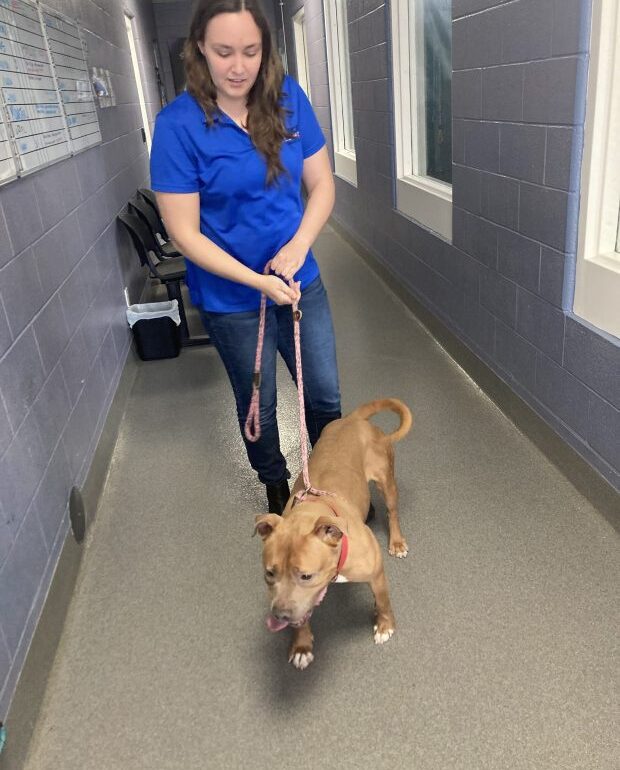The staff and volunteers at Aurora Animal Care and Control had reason to celebrate when I recently stopped by the River Street shelter.
Parsnip, the friendly, almost 3-year-old pit bull that had been at the facility for nearly two years, overlooked because of his brown color and misunderstood breed, finally found his “forever home.”
His new owner was a woman who, according to Aurora Animal Care and Control Manager Kameron DeBoer, had her eye on him for a while but also had other family members living with her who had dogs. When they moved out, the “time was right,” she said, a smile on her face.
“We are really excited for him.”
It’s success stories like these that also help keep the 27-year-old shelter manager enthused about a job that can get physically and emotionally demanding. Overseeing a city shelter with more than 174 animals is not easy.
Last month alone, some 250 animals were taken in, a record high over the past decade, says DeBoer.
It’s an unfortunate trend shelters across the country are seeing in the aftermath of the pandemic, where people were working from home and wanted pets that now are more of a burden. And the economy doesn’t help, she noted. Inflation has hit pocketbooks hard, and rising prices also include the cost of pet care.
The good news is that the shelter, which will only euthanize for medical or behavior reasons, works closely with rescue groups, and does plenty of of social media outreach to move the animals as quickly as possible, whether that’s returning them to their homes or like Parsnip, finding them new families.
“But it can get crazy,” admitted DeBoer, who had been assistant manager at Kane County Animal Control when she took over this job seven months ago.
One of the main drawbacks, she told me, is that “no one knows we are here or that we adopt” because of the shelter’s out-of-the-way location.
While the last month has seen an uptick in adoptions, “we need more foot traffic,” DeBoer insisted as she took me on a tour of the canine adoption area, which grew noisier as the animals reacted to our presence.
As expected, most of them are bully-type breeds – picked up as strays or abandoned. But the shelter also gets quite a few Chihuahuas and even huskies, which are popular but often get surrendered because “they take a lot of work,” DeBoer noted.
“There is not a bad dog in this room … they are all awesome,” she added, as the dogs greeted us with enthusiasm, barking loudly, tails wagging, some even performing a few impressive jumps inside their kennels.
All that commotion was in sharp contrast to Nova, a shy, sweet dog that was silent and still, gazing at DeBoer with complete adoration as we were introduced.
“What you see in the kennel is not the animal you will get,” she told me, noting that the more timid ones open up once they get a chance to play, and the boisterous ones settle down quickly once they get out of their kennels.
Some, like Knox, a good-looking brindle, “come in terrified … but become amazing dogs as they learn to trust,” DeBoer said.
Then there’s Monster, a black pit with tuxedo markings that’s been around a while and ”is a volunteer favorite” but has his large size working against him.
And the regal-looking Cider who is disadvantaged by that darn “brown dog syndrome” that means he can fade into the background. And sweet, shy Paris, surrendered by the owner who did not have enough time for a pet anymore. And Romeo, found as a stray the beginning of May and last week’s featured pet on the facility’s website.
And Marley and Tigger, both adopted as puppies from the shelter but recently found microchipped and abandoned next to it.
Calls to owners, said DeBoer, often get no response.
I also got to meet Oreo. He came in as a stray the first of June and just got into the adoption room, while Snickers, a high-energy dog with a tail that would not stop wagging, has the dubious distinction of being the longest resident, now that Parsnip is gone.

“It’s nothing these dogs do wrong,” De Boer insisted, noting that people tend to think the opposite if the animal has been at the shelter too long. “Unfortunately, that’s what happens with a lot of our longer-term kiddos.”
I also visited the more populated but quieter cat room, where a few kennels with kittens couldn’t help but catch my attention, as did a playful feline named Femur who, says DeBoer “knows he’s beautiful …”
And I just have to mention the independent Boba, nearly 100 days at the shelter and the longest guest of the room.
I wish I could highlight every dog and cat I met on my visit. But if you want to know more about the facility and the four-legged residents that live there, check out its website or Facebook page. Better yet, find out what hours the shelter keeps and make a visit to the building.
Just don’t pass judgment too quickly. Yes, there are a lot of pit bulls. And yes, they get loud. But they bark because they have no voice.
They bark because they want your attention. Take them outside. Give them a chance to be the dog the staff and volunteers have come to love.
Who knows: As DeBoer pointed out – and as Parsnip recently discovered – “the timing may just be right.”
dcrosby@tribpub.com
This post was originally published on this site be sure to check out more of their content.













































